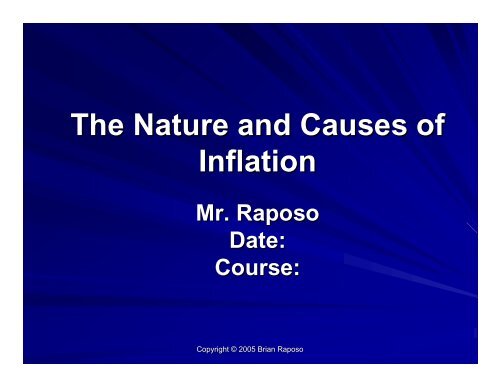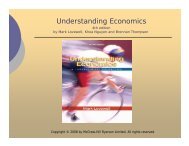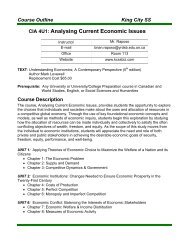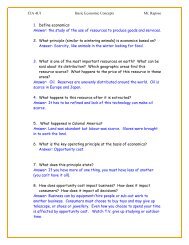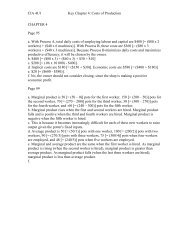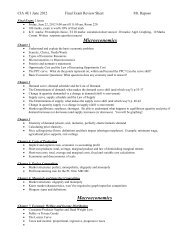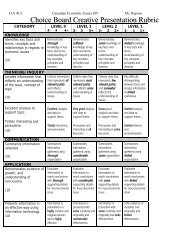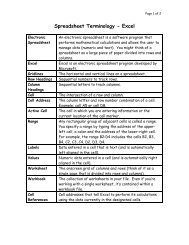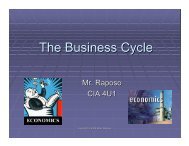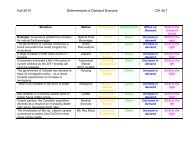You also want an ePaper? Increase the reach of your titles
YUMPU automatically turns print PDFs into web optimized ePapers that Google loves.
<strong>The</strong> <strong>Nature</strong> <strong>and</strong> <strong>Causes</strong> <strong>of</strong><br />
<strong>Inflation</strong><br />
Mr. Raposo<br />
Date:<br />
Course:<br />
Copyright © 2005 Brian Raposo
Recovery<br />
Peak<br />
<strong>The</strong> Business Cycle<br />
Peak<br />
Trough<br />
Trough<br />
Recession Recession<br />
Recession Recession<br />
Recovery<br />
Time<br />
Copyright © 2005 Brian Raposo<br />
Business Level <strong>of</strong> Activity
What Is <strong>Inflation</strong>?<br />
An increase in the<br />
general level <strong>of</strong> the<br />
prices <strong>of</strong> goods <strong>and</strong><br />
services<br />
Copyright © 2005 Brian Raposo
How Do We Measure <strong>Inflation</strong>?<br />
Consumer Price Index (CPI)<br />
<strong>The</strong> CPI is a weighted average <strong>of</strong> the prices <strong>of</strong> a<br />
“basket” <strong>of</strong> goods <strong>and</strong> services purchased by a<br />
typical household<br />
Statistics Canada takes a nationwide survey <strong>of</strong><br />
spending habits concerning 600 goods &<br />
services in the basket<br />
An average is then calculated<br />
Copyright © 2005 Brian Raposo
<strong>The</strong> Consumer Price Index<br />
Some items are more important than others<br />
(housing vs. tobacco). <strong>The</strong>refore, these items<br />
are assigned a greater weight<br />
Within each category are dozens <strong>of</strong> individual<br />
goods & services<br />
<strong>The</strong> CPI is measured in terms <strong>of</strong> how much it<br />
has changed from a base-year (1986) instead <strong>of</strong><br />
in dollars & cents<br />
Copyright © 2005 Brian Raposo
QUESTIONS?<br />
Sir, what are<br />
the weights<br />
for the CPI?<br />
Copyright © 2005 Brian Raposo
<strong>The</strong> Consumer Price Index Weights<br />
1992 CPI Weights by Major Component, for<br />
Canada, Expressed in Percentages<br />
Transportation<br />
18.3%<br />
Clothing &<br />
footwear<br />
6.6%<br />
Household<br />
operations &<br />
furnishings<br />
10.0%<br />
Health & personal<br />
care<br />
4.3%<br />
Shelter<br />
27.9%<br />
Recreation,<br />
education &<br />
reading<br />
10.4%<br />
Food<br />
18.0%<br />
Alchoholic<br />
beverages &<br />
tobacco products<br />
4.5%<br />
Copyright © 2005 Brian Raposo
<strong>The</strong> Rate <strong>of</strong> <strong>Inflation</strong><br />
<strong>The</strong> percentage increase in prices compared to<br />
prices a year earlier<br />
Demonstrated by how fast the CPI rises each<br />
year<br />
Formula:<br />
RATE OF<br />
= Current CPI - Previous Year’s CPI<br />
INFLATION Previous Year’s CPI<br />
X100<br />
Copyright © 2005 Brian Raposo
Rate <strong>of</strong> <strong>Inflation</strong>: Example<br />
1994 CPI = 130.7<br />
1995 CPI = 133.5<br />
What was the rate <strong>of</strong> inflation from 1994 to<br />
1995?<br />
Copyright © 2005 Brian Raposo
Rate <strong>of</strong> <strong>Inflation</strong>: Example<br />
1994 CPI = 130.7, 1995 CPI = 133.5<br />
RATE OF<br />
1995 CPI - 1994 CPI<br />
INFLATION = X100<br />
1994 CPI<br />
133.5 - 130.7<br />
= X100<br />
= 2.1%<br />
130.7<br />
Copyright © 2005 Brian Raposo
Question:<br />
Why do<br />
prices rise?<br />
Copyright © 2005 Brian Raposo
Why Prices Rise<br />
Analyze dem<strong>and</strong> & supply concepts when<br />
looking at inflation<br />
Example: Widget’s<br />
Equilibrium price for the product “widgets”<br />
increases from $1.00 to $1.25 over one year<br />
Copyright © 2005 Brian Raposo
What caused widgets<br />
to increase by $0.25<br />
to $1.25?<br />
Copyright © 2005 Brian Raposo
Why prices rise<br />
CASE 1: Dem<strong>and</strong><br />
Dem<strong>and</strong> for widgets<br />
in the economy<br />
increases greatly<br />
Dem<strong>and</strong> > Supply<br />
Price Increases by<br />
$0.25<br />
New Price $1.25<br />
CASE 2: Supply<br />
Widget Co. is only<br />
producer <strong>of</strong> widgets &<br />
workers belong to a<br />
union<br />
Increase in production<br />
costs causes Widget<br />
Co. to increase price<br />
by $0.25<br />
New Price $1.25<br />
Copyright © 2005 Brian Raposo
Why Prices Rise: Conclusion<br />
In both cases (widgets), the end result was<br />
the same: Price increase by $0.25 to<br />
$1.25<br />
However, causes were different<br />
CASE 1: Dem<strong>and</strong> > Supply, Dem<strong>and</strong> Side<br />
CASE 2: Producer & employees, Supply<br />
Side<br />
<strong>Inflation</strong> can come from the supply side<br />
& dem<strong>and</strong> side <strong>of</strong> the economy<br />
Copyright © 2005 Brian Raposo
Dem<strong>and</strong>-Pull <strong>Inflation</strong>:<br />
<strong>Inflation</strong> from the dem<strong>and</strong> side<br />
When excess dem<strong>and</strong> causes prices to<br />
rise, the result is dem<strong>and</strong>-pull inflation<br />
Aggregate Dem<strong>and</strong> > Economy’s<br />
(C+I+G+X-M)<br />
Production Capacity<br />
If total spending exceeds the economy’s<br />
capacity <strong>of</strong> producing goods & services,<br />
the only possible outcome is that prices<br />
will rise (due to excess dem<strong>and</strong>)<br />
Copyright © 2005 Brian Raposo
Dem<strong>and</strong> Pull <strong>Inflation</strong> Graphed<br />
$<br />
AD<br />
(C+I+G+X-M)<br />
Real<br />
Output<br />
TIME<br />
Copyright © 2005 Brian Raposo
<strong>The</strong> Money Supply & <strong>Inflation</strong><br />
Money Supply: <strong>The</strong> volume <strong>of</strong> money in circulation<br />
For prices to be driven up by society, there must<br />
be more money in circulation (rise in money<br />
supply)<br />
<strong>The</strong>refore, key factors<br />
underlying inflation:<br />
1)Level <strong>of</strong> Aggregate Dem<strong>and</strong><br />
2) Money Supply<br />
Copyright © 2005 Brian Raposo
Dem<strong>and</strong>-Pull <strong>Inflation</strong> Graphed<br />
Level <strong>of</strong> Costs & Prices Per Unit<br />
P<br />
$<br />
P2<br />
P1<br />
Volume <strong>of</strong> Output<br />
Copyright © 2005 Brian Raposo<br />
AS<br />
AD2<br />
AD AD1<br />
100
<strong>Inflation</strong> From <strong>The</strong> Supply Side:<br />
Cost-Push <strong>Inflation</strong><br />
Aggregate dem<strong>and</strong> isn’t t the only factor to<br />
inflation<br />
Supply side factors can also make inflation<br />
severe<br />
Key is some producers (business & employees)<br />
to increase their incomes & price paid by<br />
consumer<br />
In this case, price is being pushed up by cost<br />
factors (increase in pr<strong>of</strong>it & wages)<br />
Thus the term “cost-push inflation”<br />
Copyright © 2005 Brian Raposo
2 Key Issues Behind Cost-Push<br />
<strong>Inflation</strong><br />
1) Market Power<br />
Ability <strong>of</strong> some<br />
producers to increase<br />
their prices(monopoly<br />
<strong>and</strong> some employees to<br />
increase their wages<br />
(unions)<br />
EG: Automobile,<br />
petroleum, Telephone<br />
Service)<br />
Copyright © 2005 Brian Raposo
2) WAGE-PRICE SPIRAL<br />
•During periods <strong>of</strong> inflation,<br />
employers may grant wage<br />
increases to employees<br />
(passing the increase cost on to<br />
higher prices for consumers)<br />
•If many prices are rising this<br />
way (increase in cost <strong>of</strong><br />
living), unions may dem<strong>and</strong><br />
more wage increases<br />
•This may create a wage-price<br />
spiral where wages & prices<br />
chase each other upwards<br />
Copyright © 2005 Brian Raposo
Cost-Push <strong>Inflation</strong> Graphed<br />
Level <strong>of</strong> Costs & Prices Per Unit<br />
P<br />
$<br />
P1<br />
AS1<br />
AS<br />
Volume <strong>of</strong> Output<br />
Copyright © 2005 Brian Raposo<br />
AD<br />
100
<strong>Inflation</strong> Psychology<br />
People who have experienced inflation for<br />
sometime come to expect that rapid<br />
inflation will continue in the future<br />
<strong>Inflation</strong> is made more severe as people<br />
seek higher wages (cost-push) <strong>and</strong> by<br />
spending their money now, before prices<br />
rise further (dem<strong>and</strong>-pull)<br />
Copyright © 2005 Brian Raposo
<strong>Inflation</strong> Psychology Graphed<br />
Level <strong>of</strong> Costs & Prices Per Unit<br />
P<br />
$<br />
P1<br />
AS1<br />
AS<br />
Volume <strong>of</strong> Output<br />
Copyright © 2005 Brian Raposo<br />
AD1<br />
AD<br />
100
How <strong>Inflation</strong> Gains Momentum<br />
Excessive<br />
Aggregate<br />
Dem<strong>and</strong><br />
<strong>Inflation</strong><br />
<strong>Inflation</strong> Psychology:<br />
Rapid Increase<br />
In Wages<br />
Salaries<br />
People Spend<br />
More/Save<br />
Less<br />
Additional “Cost-Push” Pressures on Price<br />
+<br />
Additional “Dem<strong>and</strong>-Pull” Pressures on Price<br />
+<br />
Pressures On Gov’t To Increase Money Supply<br />
To Avoid An Economic Downturn<br />
Copyright © 2005 Brian Raposo
Summary<br />
<strong>The</strong> causes <strong>of</strong> inflation in review<br />
1) Excessive aggregate dem<strong>and</strong><br />
2) Increase or growth in money supply<br />
3) Increase in producers costs<br />
Copyright © 2005 Brian Raposo


